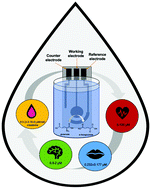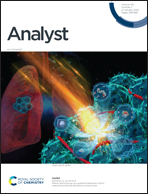Glutamate sensing in biofluids: recent advances and research challenges of electrochemical sensors
Abstract
Glutamate is a nonessential amino acid and a putative neurotransmitter. When its consumption exceeds its synthesis, it becomes necessary to monitor its levels. Hence, a low-cost, sensitive and real-time monitoring of glutamate to quantify pain and detect neurodegenerative diseases is imperative to improve pharmacotherapy and early diagnosis for health care. While enzymatic electrochemical sensors are promising to address issues in lab-based detection techniques, non-enzymatic sensors are better due to their higher stability and lower cost. In this review, we aim to discuss the recent advances and remaining challenges of sensing glutamate in biofluids. First, we discuss the metabolic routes of glutamate, followed by its transmission processes to the biofluids. Second, we identify the connection of glutamate to pathologies as a potential biomarker. Third, we emphasize electrochemical sensors instantaneously detect glutamate in biofluids in real-time, quantifying pain and monitoring neurodegenerative diseases. The literature shows the concentration of glutamate in biofluids, such as plasma, cerebral spinal fluid, urine, and saliva are in the range of 5–100 μM, 0.5–2 μM, 8.5 (3.3–18.4) μM mM−1 creatinine, and 0.232 ± 0.177 μM respectively. While these concentration levels are sometimes lower than the detection limit of electrochemical sensors, functionalization of the nanomaterials currently being used such as NiO and Co3O4 with carbon nanotubes or beta-cyclodextrin may improve the sensing performance. Another key challenge in the research is to develop relationships between glutamate and biofluids. Finally, we have to advance electrochemical sensors that are compatible to detect glutamate in physiological conditions for long durations of time.



 Please wait while we load your content...
Please wait while we load your content...